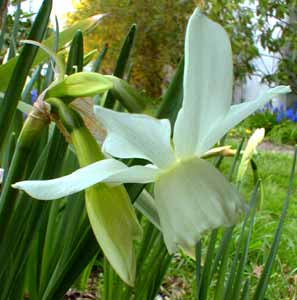
'Thalia'
White Miniature
Angel Tears
"I'll bring a bevy,
A hundred black-eyed maids that love as I do
With chaplets on their heads of daffodillies."
-Shakespeare,
Two Noble Kingdoms
Two Noble Kingdoms
Narcissus triandrus is frequently mispelled triandus. It is native to Spain, Portugal & southern France.
The common name "Angel's Tears" has been bestowed upon the species because the flowers bend downward in an attitude of sadness or prayer, though the tilt is rarely so exaggerated for 'Thalia' that you cannot see its whole face with perfect ease.
Such tilted blooms are additionally symbolic of the self-obsessed demigod Narcissus who bowed his head in order to see himself reflected in a pool, although the species more closely associated with the myth of Narcissus & the nymph Echo is N. tazetta, probably the oldest species in continuous cultivation since ancient times.
There are many people who will not bring daffodils into the house, out of the superstitious belief that these flowers bring with them sorrows of the grave. Even Socrates called narcissi "chaplets of the infernal gods." White daffodils have come to be more associated with death than are yellow, & such scented white narcissus as the popular cultivar 'Thalia' have been known as Grave Flowers & regarded as especially unlucky to bring indoors.
On the Isle of Mann it is said that they are only safely brought indoors after the first goose egg hatches, hence the common names Goose Herb, Goose Leeks, or Gooseflops. The association with geese derives from the flowers having long necks with their pointed unopened bowed buds suggestive of pecking geese; & the bulb itself would be the goose's egg.
In Herfordshire it was similarly believed that daffodils were unlucky to bring into the house until after the hens begin sitting, accounting for the occasional common name Hens & Chickens, a name today more associated with succulent Sempervivums.
'Thalia' is an heirloom known to gardening since before 1916, having been developed by M. van Waveren & Sons, a famous nursery in Hillegom, Holland, which was founded in 1822. It has white flowers with vague greenish tinge, atop eight to twelve-inch stems amidst somewhat floppy leaves of similar height
Each stem produces multiple blooms, generally two or three, but sometimes more. The petals are slightly reflexed. The species name refers to its "Three Stamens." In pure beauty this is truly one of the most outstanding cultivars, & without competition my favorite white.
It is an easy variety to force indoors (despite the superstitions against doing so), or for use in containers, & are long-lasting as cut flowers. In a temperate garden it flowers as early as February, though in our garden it is only getting going for full flower-power in the last part of March.
This variety need not be lifted for many years if placed in a sunny spot in the garden. It will slowly naturalize. But eventually the bulbs can be dug up to be divided. As for most miniatures, N. triandus bulbs should be planted three to five inches deep, which is not quite as deep as for full-sized Angel Tears which can go eight inches deep.
N. triandrus easily hybridizes with other nearby daffodils, so if permitted to naturalize, they may after many years reveal offspring of random appearance. To preserve it as 'Thalia' per se, it is a good idea to deadhead the spent flowers before they go to seed, in which case it will probably produce more bulb offsets than it would've produced seeds anyway. Then it can be propogated by lifting the bulbs every few years for division of the new bulbs, which are not only true to the parent but will be blooming way faster than from the seeds.
If random hybrids are of interest, of course, a patch of 'Thalia' can be left to go to seed, baring in mind it takes four to seven years for the seeds to become bulbs that bloom.
As one of the more fragrant of daffodils, it was essential to find locations for them where their aroma can be appreciated. We planted fourteen autumn bulbs at the morning-sun edge of the Chokecherry tree, amidst autumn-flowering Cyclamen hederifolium 'Album.' This location is at the edge of a small lawn-area we use for picnics. The majority of our lawns have been slowly replaced by woodsy gardens, but we are saving this lawned "clearing" specifically because sitting out on the grass can be so joyful. In early spring we get to sit down right beside the redolent 'Thalia' for many a luncheon.
Another ten or so bulbs were placed on the very edge of a sidewalk on a raised garden ledge, in front of the Jeanne Marie de Montague Rhododendron, where passing foot-traffic can appreciate the scent. Immediately behind 'Thalia' is a drift of N. minor var. pumilus 'Rip Van Winkle' which are in front of three large bulbs for N. tazetta var orientalis 'Chinese Sacred Lily.' These are collectively a bit more delicate than the majority of narcissus varieties, but have such good sun & perfect drainage in this location they have done well.